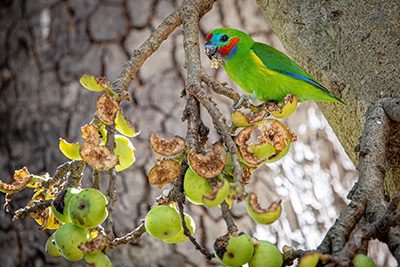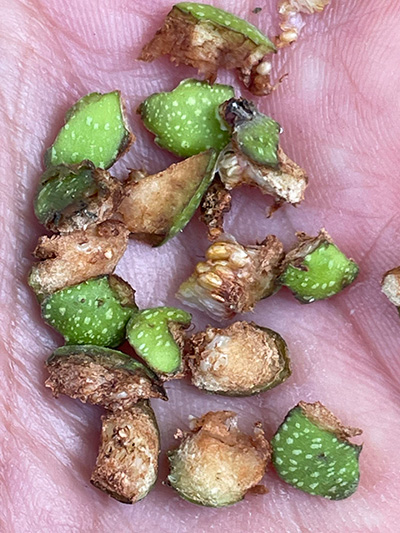Coxen’s fig parrot
Searching for Coxen’s fig-parrots in subtropical forests
As subtropical rainforests become more fragmented, Coxen’s fig-parrot faces a challenging future unless we can discover more about this elusive bird.

Fast facts
Common name: Coxen’s fig-parrot (a subspecies of the double-eyed fig-parrot)
Scientific name: Cyclopsitta diophthalma coxeni
Family: Psittaculidae (parrots, lorikeets and rosellas)
Status: Critically endangered
Habitat: Lowland and upland subtropical rainforest (including gallery and littoral rainforest) and wet eucalypt forest that supports abundant fruiting trees, particularly native figs
Species overview
With its green, blue and red colouring and small size, Coxen’s fig-parrot blends into the rainforest canopy.
This subspecies may occur on the Country of First Nations peoples, including the Bundjalung, Butchulla, Turrbal, Yugara, Waka Waka and Yaegl. We are still gathering knowledge about the bird’s cultural significance, ecology and behaviour.
Coxen’s fig-parrot is the southernmost of three Australian subspecies of the double-eyed fig-parrot. The two other subspecies are Macleay’s fig-parrot in the Wet Tropics and Marshall’s fig-parrot on Cape York. Coxen’s fig-parrot appears to have diverged from its nearest relative, Macleay’s fig-parrot, within the last million years.
In 1867, John Gould scientifically described the bird, naming it after his brother-in-law, Charles Coxen. Mr Coxen a natural history collector provided Gould with specimens collected in 1866 by a sawyer at Mount Samson near Brisbane.
This rapid-flying bird once lived in lowland rainforests across a distribution extending from Rockhampton to the New South Wales border and beyond to the Richmond River of New South Wales. In the last 100 years, the Coxen’s fig-parrot population has declined sharply with the widespread clearing of lowland rainforests and the logging of trees.
Over the past two decades, targeted surveys have not recorded Coxen’s fig-parrot, leading many in the scientific and general communities to believe the bird may be extinct.
However, members of the public (including some experienced naturalists) continue to report occasional incidental sightings, giving hope that this enigmatic parrot still exists. Estimates suggest fewer than 50 mature Coxen’s fig-parrots remain in the wild. The last recorded credible sighting was in 2020.

Behaviour and ecology
Coxen’s fig-parrots feed mainly on the seeds of native figs but also eat other native rainforest fruits, lichen, insect larvae within fruits, and nectar. These birds also reportedly feed on the fruits of introduced species, such as the edible fig, cotoneaster and loquat.
When fig-parrots consume figs, they bite off small pieces, consume the seeds and then discard the flesh, which drops to the ground. Beneath the fig trees where fig-parrots have fed, you will find characteristically shaped remains of the fruit shards scattered on the forest floor.
The calls of Coxen's fig-parrot have not been recorded, but they are reportedly like those of Macleay’s and Marshall’s fig-parrots. The flight call is typically a repeated, short, clipped, high-pitched 'zeet' or ‘zzzt’.
The subspecies’ breeding habits are not well-documented due to its small population size and elusive nature. However, like other fig-parrots, it likely excavates nest chambers in dead tree trunks and branches, sometimes high up in mature forest trees.
Characteristics
Coxen’s fig-parrot has:
- a length of 13–16cm
- a predominantly green body
- a disproportionately large head and bill
- a distinctive blue and red face pattern
- blue outer wings and a red spot at each upper-wing base
- a pale stripe visible on the underwings when flying
- a stumpy tail.
Threats
- Habitat loss, fragmentation and degradation
- Seasonal gaps in food availability
- Increased frequency and duration of extreme events (e.g. droughts and wildfires)
- Issues associated with small population size and low genetic diversity
- Introduced invasive plants (weeds)
- Disease is a potential threat
- Poaching or nest robbing is a potential threat.
What’s being done?
- We are part of the Coxen’s fig-parrot recovery team, which convenes when it receives reliable sightings, confirmed call recordings of the wild bird or a nest discovery.
- By compiling information about reported sightings, we have focused on understanding the potential population size and distribution of Coxen’s fig-parrot in Queensland.
- We have developed state-of-the-art monitoring techniques, including installing long-term acoustic recording devices in key habitat areas.
Who is helping?
- Currumbin Wildlife Sanctuary We partner with the Sanctuary to search for Coxen’s fig-parrot in the bird’s known habitat. The Sanctuary maintains a captive population of Macleay’s fig-parrot, a close relative of Coxen’s fig-parrot, to refine captive husbandry techniques that we can hopefully apply to a future Coxen’s fig-parrot breeding program.
- Noosa and District Landcare
We support this group’s work to involve the community in searching for and reporting sightings of Coxen’s fig-parrot and recording its calls, as well as replanting its food trees and restoring suitable habitat. - Ted Pedersen/Pedersen Biological and Environmental (PBE) Trust
Research partner PBE Trust is developing techniques for the automated call detection of the Coxen’s fig-parrot from large volumes of environmental sound recordings using a combination of software-based and machine-learning (AI) approaches. - International institutions
We are collaborating with researchers from overseas institutions using funding from National Geographic to develop and test the ability of a low-cost, open-source acoustic device. The device will send real-time alerts when triggered by Macleay’s fig-parrot calls. Eventually, we hope this project will provide cost-efficient acoustic detection and monitoring technology for the search for Coxen’s fig-parrots. - Queensland Museum
The Museum has several historic Coxen’s fig-parrot specimens, which researchers have used to obtain DNA data. These new genetic data help us understand the evolutionary history of the bird.
How you can help
- Report Coxen’s fig-parrot sightings by emailing Threatened.Species@des.qld.gov.au
- Plant fig trees on your property. The fig-parrot feeds primarily on the seeds of figs and other rainforest fruit trees/plants.
- Participate in local rainforest rehabilitation or replanting projects.
- Support Currumbin Wildlife Sanctuary’s research.
- Volunteer to help with the Noosa and District Landcare surveys.
- Make a donation to support Queensland threatened species protection and science and research-based initiatives.
- Find out more about how you can help support threatened species efforts.